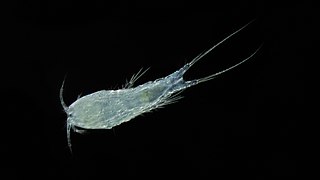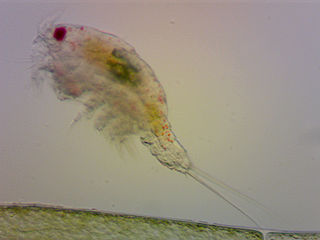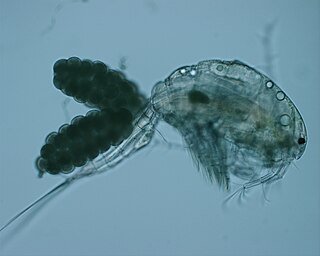Related Research Articles

Canthocamptus is a genus of copepods that live in water from the Arctic Ocean to the Atlantic Ocean. There are over 200 different species of Canthocamptus. A number of Australian endemic species are listed as vulnerable species on the IUCN Red List, and one Brazilian species is conservation dependent.
Acanthocyclops is a genus of copepod crustaceans in the family Cyclopidae. It was originally described by Friedrich Kiefer as a subgenus of Cyclops, and contains the following species:
Afrocyclops is a genus of copepod crustaceans in the family Cyclopidae, containing the following species:
Arctodiaptomus is a genus of copepods in the family Diaptomidae, containing the following species:
Argyrodiaptomus is a genus of copepods in the family Diaptomidae, containing the following species:

Attheyella is a genus of copepods in the family Canthocamptidae, containing the following species:
Elaphoidella is a genus of freshwater copepods in the family Canthocamptidae. It contains over 200 species, including three classified as vulnerable species by the IUCN – three endemic to Slovenia and one endemic to the United States. In total, the genus Elaphoidella contains the following species:

Mesocyclops is a genus of copepod crustaceans in the family Cyclopidae. Because the various species of Mesocyclops are known to prey on mosquito larvae, it is used as a nontoxic and inexpensive form of biological mosquito control.
Metacyclops is a genus of copepod crustaceans in the family Cyclopidae, containing 61 species, of which three are listed on the IUCN Red List – M. campestris from Brazil, M. gasparoi from Italy (vulnerable) and M. postojnae from Slovenia (vulnerable).
Nitocrella is a genus of copepod. Although most other genera in the family Ameiridae are marine, species of Nitocrella are almost exclusively found in subterranean fresh water or brackish water. More than 80 species are included in the genus, including two which are listed as vulnerable species on the IUCN Red List:
Notodiaptomus is a genus of copepods in the family Diaptomidae. It is the most widely distributed, most abundant and most species-rich genus of freshwater calanoid copepods in the Neotropics. The genus was erected in 1936 by Friedrich Kiefer for eleven species formerly placed in a wider Diaptomus. Notodiaptomus deitersi was chosen to be the type species by Raúl Adolfo Ringuelet in 1958.
Phyllodiaptomus is a genus of crustacean in the family Diaptomidae. It includes the following species:

Thermocyclops is a genus of crustacean in family Cyclopidae. It was first described and later extensively researched by Friedrich Kiefer, who discovered some 20 species. The species and subspecies of the genus inhabit fresh and brackish waters alike all around the world, although most are from tropical areas.
Tropodiaptomus is a genus of copepods in the family Diaptomidae. It includes the following species, many of which are narrow endemics and are included on the IUCN Red List :

Diaptomidae is a family of freshwater pelagic copepods. It includes around 50 genera:

The Cyclopidae are a family of copepods containing more than half of the 1,200 species in the order Cyclopoida in over 70 genera.
Megacyclops is a genus of copepods, containing the following species:
Halicyclops is a genus of copepods belonging to the family Cyclopidae. There are currently 94 described species found in brackish habitats throughout the world:
Microcyclops is a genus of copepods, containing the following species:
References
- ↑ WoRMS (2010). T. Chad Walter & Geoff Boxshall (ed.). "Tropocyclops Kiefer, 1927". World Copepoda database. World Register of Marine Species. Archived from the original on August 13, 2011. Retrieved March 26, 2010.